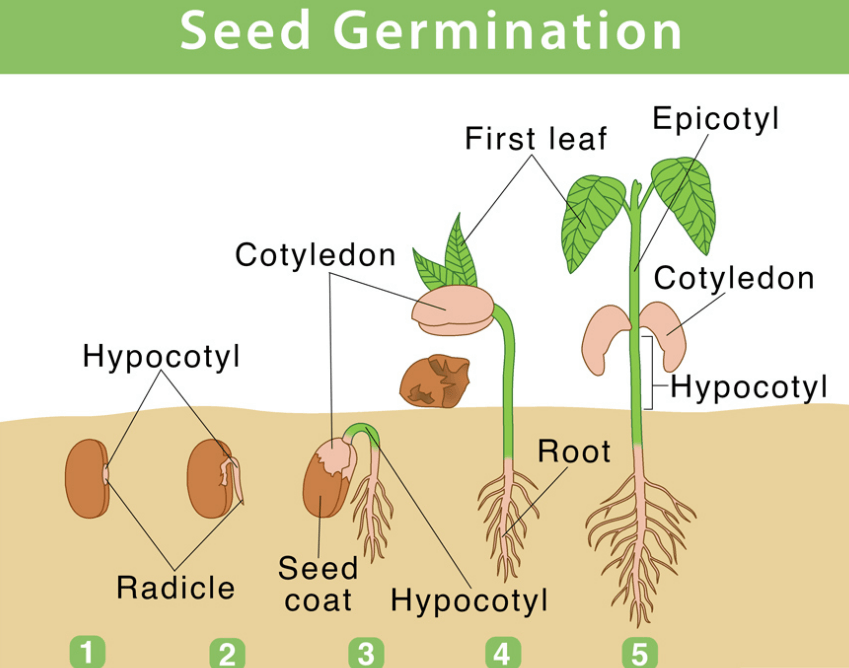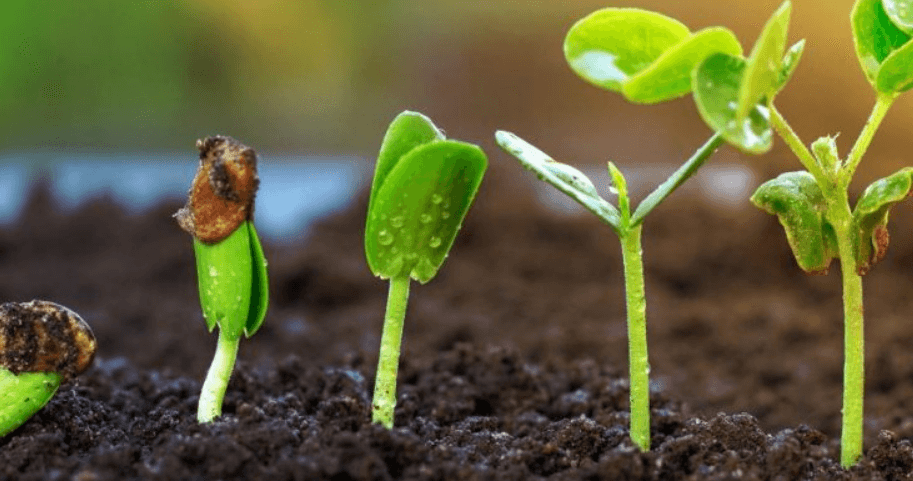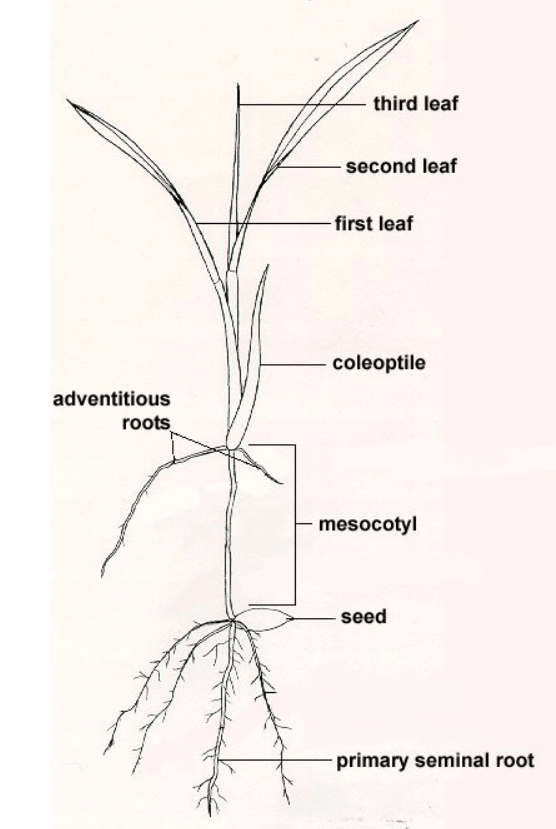Germination Definition
The emergence of an organism from a seed or spore is called germination. It describes the emergence of a pollen tube from a pollen grain of a seed plant, the germination of a seedling from an angiosperm or gymnosperm seed, and the emergence of a cell from a spore, such as a spore from a fungus, fern, or bacteria. Process of GerminationThe following describes the germination process:
Temperature for GerminationThe temperature is vital for germination, among other factors. Despite the temperature changing the plant's growth rate and metabolism, most plants will germinate throughout a wide temperature range (e.g., 16 to 24 degrees Celsius). Some plants require warm settings to grow, while others require chilly ones, depending on the local temperature. Moreover, several plant species need temperature changes between cold and warm to break dormancy and encourage germination. For instance, some seeds must be exposed to freezing winter temperatures (4 to -5 degrees Celsius) before germination. Still, other sources must be cracked by scorching temperatures (such as those produced by forest fires) to start germination. It is regarded as a system that forecasts optimum growth circumstances. For instance, some seeds take up water in the fall and then burst during the chilly winter months. Once the soil has warmed back up, the sprout and roots will start to show, producing a seedling just as the amount of water and sunlight increases in the spring and summer. Conditions for the Germination of SeedsOxygen: Oxygen is essential for seeds to grow properly. For metabolism, the germination of the embryo requires oxygen. Until the source can develop leaves, it is employed as a component of aerobic respiration. It is present in the pores of the soil particles. The seed could be starved of oxygen if buried deeply, though. Water: The process of seed germination is referred to as sprouting. Water is a necessary ingredient to start this procedure. Some seeds must be consumed with water since they are dry. It aids in giving the developing bean embryo the dissolved oxygen it needs to grow and the essential hydration for protoplasm's vital functions. It improves seed permeability while also softening seed coatings. Temperature: The ideal temperature for different seeds varies. The average temperature range for seed germination is between 25 and 30 degrees Celsius. Some sources might need a temperature as low as 5 degrees Celsius, while others might need a temperature as high as 40 degrees Celsius.
Seed Dormancy
There is a danger that a seed will germinate even if given all the ingredients a source needs to flourish and is considered viable. Dormancy, a phenomenon, is to blame for this. Even when seeds are exposed to all the necessary conditions, a condition known as seed dormancy prevents them from germination. So what causes seed dormancy? Dormancy in seeds is not an error; instead, it is a sophisticated method of protecting roots. The germination process is staggered to protect some seedlings from threats, such as severe weather or predators. For instance, the seeds of spring-blooming plants have decided only to sprout once the chilly winter weather has passed. It is a self-protective action. How do seeds emerge from their dormancy? Removing the seeds' physical or chemical dormancy factors is necessary for them to emerge from dormancy. Some sources have a thick, extremely resistant covering contributing to their physical inactivity. Specific chemical characteristics in other seeds prevent germination from occurring. It is a component of chemical dormancy. Emerging germination
Although in some species (such as the coconut), the stalk, or plumule, emerges first, active growth in the embryo often starts with the radicle, the primary root from which the origin gets its name, arising from the seed. Early development is primarily dependent on cell expansion, but soon after, cell division starts in the radicle and early shoot. After that, growth and subsequent organ creation (organogenesis) depend on the typical mix of cell number rise and size enlargement. The seedling depends on the parent sporophyte's stores until it can support itself nutritionally. In angiosperms, these reserves can be located in the endosperm, the ovule's excess tissues, or the embryo's body, typically in the cotyledons. Food components are primarily found in the female gametophyte of gymnosperms. Although reserve materials frequently exist as partially insoluble forms, such as starch grains, protein granules, lipid droplets, and similar entities, the early metabolism of the seedling is mainly focused on mobilizing reserve materials and transferring the byproducts to active regions. The embryo and, in some cases, specialized endosperm cells produce enzymes that break down reserves outside the root. The cotyledons, which eventually enlarge in the light to become the first organs involved in photosynthesis, are how some seeds (like castor beans) absorb nutrients from reserves. If the resources are kept in the cotyledons, they may shrink after germination and perish or produce chlorophyll and start to make their food. When a seedling is establishing itself as a rooted plant, and during other stages of growth, environmental conditions play a crucial role in determining its orientation. It matters how the seedling responds to gravity. The radicle is described as positively geotropic because it often grows downward into the earth. Because it rises above the soil and moves away from it, the young shoot, or plumule, is described as being negatively geotropic. It does this by either extending the hypocotyl, which is the region between the radicle and the cotyledons, or the epicotyl, which is the portion above the level of the cotyledons. The cotyledons are removed from the soil if the hypocotyl is expanded. The cotyledons stay in the ground if the epicotyl lengthens. Light has an impact on the seedling's morphology and orientation. When a seed germinates beneath the soil's surface, the plumule may emerge with its head bent to protect its sensitive tip, but when exposed to light, it will straighten out (the curvature is retained if the shoot emerges into darkness).In line with this, immature leaves do not expand and turn green in plants like the bean until they are exposed to light. It is known that processes involving the light-sensitive pigment phytochrome control these adaptive responses. Most seedlings exhibit positive phototropism, or a solid attraction to light, in the shoot, which is most pronounced when the light comes from a single direction. This positive phototropism increases the possibility that the plant's aerial components will land in the area most conducive to photosynthesis when combined with the reaction to gravity. Seed Germination Influencing Factors:
A few key variables impact seed germination. They consist of the following:
External Components:
Sometimes, a temperature below the moderate range retards seed germination and encourages fungal growth. At temperatures over the reasonable limit, germination can sometimes end. Internal Components: Dormancy of Seeds In this situation, the seeds are stopped from germinating even when the conditions are favorable. While seeds are dormant:
The Conclusion:The theory is that if the germination rates of radish seeds are tested in three different media?tap water, salt water, and sugar water?the seeds set to germinate in tap water will do so the fastest and have the highest germination rates, while the sources set to grow in salt water will do so more slowly and have the lowest germination rates. The seeds germinating in sugar water will do so more slowly and have the lowest germination rates. Because the data showed that seeds set to grow in tap water had the highest germination rate (95% of the sources germinated), seeds set to sprout in water saturated with salt had the lowest germination percentage (40%) and, as expected, the percentage of seeds set to germinate in water saturated with sugar had a germination rate in-between those of tap water and water saturated with salt (85%), this is because the seeds set to germinate in tap water had the highest germination rate.
Next TopicAgreement Definition
|
 For Videos Join Our Youtube Channel: Join Now
For Videos Join Our Youtube Channel: Join Now
Feedback
- Send your Feedback to [email protected]
Help Others, Please Share










